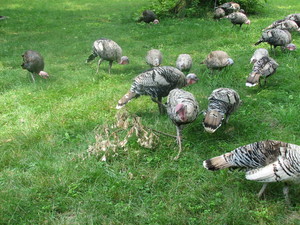
The Call Again Farm Journal
05 Apr Sun 2009
Change I Believe In
Tonight, when I brought the turkeys into the barn, I saw my first two violets of the year. For some people, crocuses or daffodils are their favorite indicators of spring among flora, but for me, it's violets. Crocuses often come up in early March, only to be buried in a week of snow storms, but violets usually don't start showing up until the arrival of spring weather is imminent. (Incidentally, since we were speaking of daffodils, the daffodils at church were blooming today.)
Now, I admit that tomorrow night, snow is in the forecast. However, it should only be a light dusting. The little purple wild violets in my yard are just the latest in a long series of signs in nature, including many sightings of our local crestless male cardinal and his crested lady, hearing peepers, seeing kettles of migrating hawks, a bush in the back yard with the green buds of leaves, and the lengthening of the days, that the change of seasons is happening. There may be setbacks, like the little snow that may come soon, but this is only one step back. For every one step back, there are many bounds forward. In several weeks, spring will be in full throttle. I've seen this change many times, yet every year it fills me with awe. This is a change that I truly believe in - and love.
In incubation news, I put a second batch of twenty-nine turkey eggs in the incubator last night. I also noticed that another one of my turkey hens, Two-Tone, is flirting with broodiness. This is what I call the early stages of broodiness (a mother bird deciding to incubate eggs) where the hen sits on the eggs for a while, then will get off for a day or two, then get back on, etc. After a few days, she'll either settle down to be a good, reliable broody or, in a few unusual cases, abandon the nest.
Barbara Kingsolver's "Miracle"
What is the result of one southwestern family’s decision to kick their oil and water addictions by moving to Virginia and becoming locavores?Animal, Vegetable, Miracle, a book written primarily by the acclaimed novelist and essayist Barbara Kingsolver, with contributions from her elder daughter, Camille Kingsolver, and her husband, Steven Hopp.
Animal, Vegetable, Miracle is both an account of Barbara Kingsolver and her family’s year of eating almost exclusively locally and an effort to convince others to follow their lead.In support of the latter, the authors provide a damning look at our current agricultural and food distribution systems in this country.They cite all sorts of reasons to support local farmers instead of huge agribusiness, from the distance food normally travels to reach your plate* to GMOs, and refutes the claims that eating locally is expensive and elitist.In fact, they don’t simply advocate eating locally, they’re truly advocating eating ethically.Barbara Kingsolver and her family only eat grass fed meats, and prefer produce produced with sustainable methods.
My favorite parts of the book were the ones on poultry.Barbara Kingsolver’s younger daughter, Lily, decides to start a business selling eggs and raising chickens for meat.I smiled at the parts talking about Lily pouring over hatchery magazines, because one of my favorite things to do when bored is to read all about poultry breeds on hatchery websites.Barbara Kingsolver herself decides to raise Bourbon Red turkeys, a heritage breed, and I laughed out loud at her descriptions of turkey reproduction.I know all about it, and have seen every step a million times, but she made it very, very hilarious.
My only complaint is the lack of day-to-day details of how they were coping with the lack of out-of-season food, especially in the first third or half of the book.I do admit they included some nice recipes throughout, though.In later parts of the book, she talks a lot about poultry, of course, as well as canning and generally what they were eating.My favorite chapter title was probably “Zucchini Larceny”.However, in the beginning, it’s more of reasons to eat local then what the family was eating locally.Perhaps it’s because there isn’t much local food in spring, so it’s hard to write a lot about not much.
The other book I’ve been reading about eating organically/locally is The Omnivore’s Dilemma, which is well written for nonfiction, but Animal, Vegetable, Miracle is nonfiction that reads like a novel.I highly recommend reading it.However, I do feel obligated to warn you that you may finish the book and never be able to food from out of your region again.
